MGMT6018 Assessment 1: Brazil vs Australia Legal Systems Report
VerifiedAdded on 2021/04/24
|6
|2239
|58
Report
AI Summary
This report provides a comparative analysis of the legal systems of Brazil and Australia, focusing on key areas such as parliamentary systems, court structures, contract law, agency, employment law, torts, patents, copyright, and trademarks. The report highlights the differences and similarities between the two nations' legal frameworks, examining the influence of English law on Australian legal principles and the civil law tradition in Brazil. It covers specific aspects like the language requirements in contracts, the role of labor unions in Brazil, and the protection of intellectual property rights in both countries. The report references relevant legislation, case law, and legal precedents, offering a comprehensive overview of the legal landscape in both Brazil and Australia.
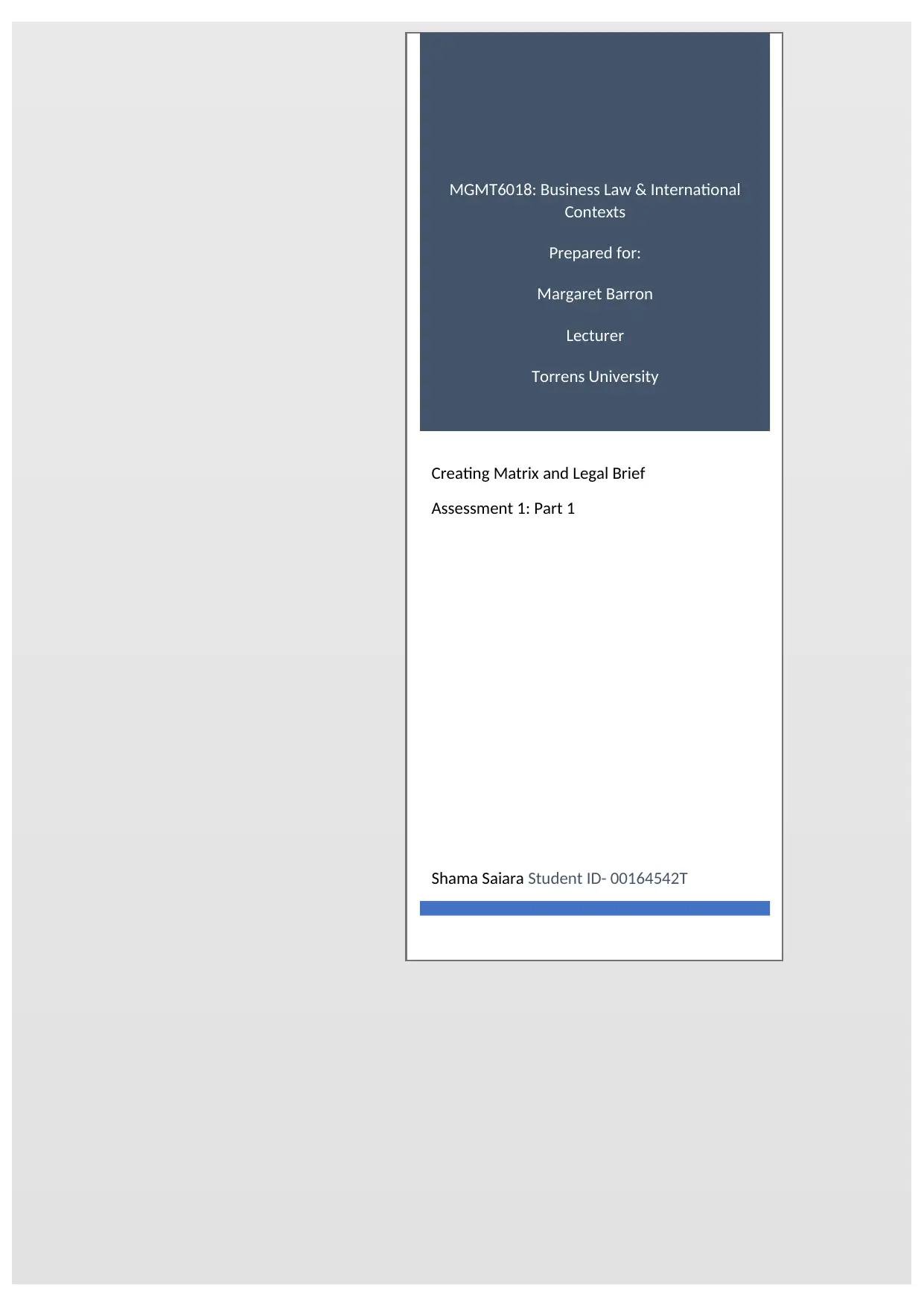
MGMT6018: Business Law & International
Contexts
Prepared for:
Margaret Barron
Lecturer
Torrens University
Creating Matrix and Legal Brief
Assessment 1: Part 1
Shama Saiara Student ID- 00164542T
Contexts
Prepared for:
Margaret Barron
Lecturer
Torrens University
Creating Matrix and Legal Brief
Assessment 1: Part 1
Shama Saiara Student ID- 00164542T
Paraphrase This Document
Need a fresh take? Get an instant paraphrase of this document with our AI Paraphraser
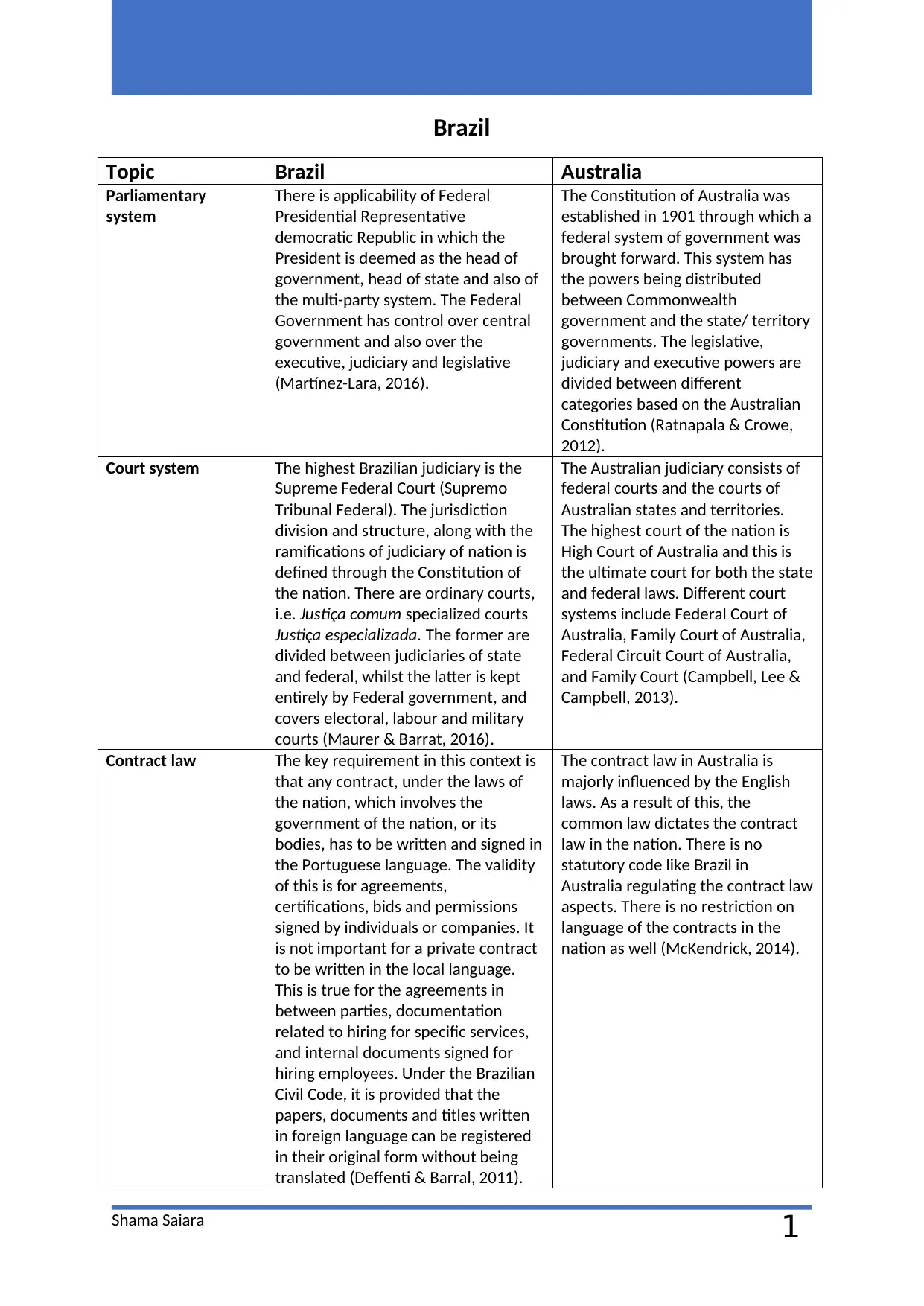
1
Brazil
Topic Brazil Australia
Parliamentary
system
There is applicability of Federal
Presidential Representative
democratic Republic in which the
President is deemed as the head of
government, head of state and also of
the multi-party system. The Federal
Government has control over central
government and also over the
executive, judiciary and legislative
(Martínez-Lara, 2016).
The Constitution of Australia was
established in 1901 through which a
federal system of government was
brought forward. This system has
the powers being distributed
between Commonwealth
government and the state/ territory
governments. The legislative,
judiciary and executive powers are
divided between different
categories based on the Australian
Constitution (Ratnapala & Crowe,
2012).
Court system The highest Brazilian judiciary is the
Supreme Federal Court (Supremo
Tribunal Federal). The jurisdiction
division and structure, along with the
ramifications of judiciary of nation is
defined through the Constitution of
the nation. There are ordinary courts,
i.e. Justiça comum specialized courts
Justiça especializada. The former are
divided between judiciaries of state
and federal, whilst the latter is kept
entirely by Federal government, and
covers electoral, labour and military
courts (Maurer & Barrat, 2016).
The Australian judiciary consists of
federal courts and the courts of
Australian states and territories.
The highest court of the nation is
High Court of Australia and this is
the ultimate court for both the state
and federal laws. Different court
systems include Federal Court of
Australia, Family Court of Australia,
Federal Circuit Court of Australia,
and Family Court (Campbell, Lee &
Campbell, 2013).
Contract law The key requirement in this context is
that any contract, under the laws of
the nation, which involves the
government of the nation, or its
bodies, has to be written and signed in
the Portuguese language. The validity
of this is for agreements,
certifications, bids and permissions
signed by individuals or companies. It
is not important for a private contract
to be written in the local language.
This is true for the agreements in
between parties, documentation
related to hiring for specific services,
and internal documents signed for
hiring employees. Under the Brazilian
Civil Code, it is provided that the
papers, documents and titles written
in foreign language can be registered
in their original form without being
translated (Deffenti & Barral, 2011).
The contract law in Australia is
majorly influenced by the English
laws. As a result of this, the
common law dictates the contract
law in the nation. There is no
statutory code like Brazil in
Australia regulating the contract law
aspects. There is no restriction on
language of the contracts in the
nation as well (McKendrick, 2014).
Shama Saiara
Brazil
Topic Brazil Australia
Parliamentary
system
There is applicability of Federal
Presidential Representative
democratic Republic in which the
President is deemed as the head of
government, head of state and also of
the multi-party system. The Federal
Government has control over central
government and also over the
executive, judiciary and legislative
(Martínez-Lara, 2016).
The Constitution of Australia was
established in 1901 through which a
federal system of government was
brought forward. This system has
the powers being distributed
between Commonwealth
government and the state/ territory
governments. The legislative,
judiciary and executive powers are
divided between different
categories based on the Australian
Constitution (Ratnapala & Crowe,
2012).
Court system The highest Brazilian judiciary is the
Supreme Federal Court (Supremo
Tribunal Federal). The jurisdiction
division and structure, along with the
ramifications of judiciary of nation is
defined through the Constitution of
the nation. There are ordinary courts,
i.e. Justiça comum specialized courts
Justiça especializada. The former are
divided between judiciaries of state
and federal, whilst the latter is kept
entirely by Federal government, and
covers electoral, labour and military
courts (Maurer & Barrat, 2016).
The Australian judiciary consists of
federal courts and the courts of
Australian states and territories.
The highest court of the nation is
High Court of Australia and this is
the ultimate court for both the state
and federal laws. Different court
systems include Federal Court of
Australia, Family Court of Australia,
Federal Circuit Court of Australia,
and Family Court (Campbell, Lee &
Campbell, 2013).
Contract law The key requirement in this context is
that any contract, under the laws of
the nation, which involves the
government of the nation, or its
bodies, has to be written and signed in
the Portuguese language. The validity
of this is for agreements,
certifications, bids and permissions
signed by individuals or companies. It
is not important for a private contract
to be written in the local language.
This is true for the agreements in
between parties, documentation
related to hiring for specific services,
and internal documents signed for
hiring employees. Under the Brazilian
Civil Code, it is provided that the
papers, documents and titles written
in foreign language can be registered
in their original form without being
translated (Deffenti & Barral, 2011).
The contract law in Australia is
majorly influenced by the English
laws. As a result of this, the
common law dictates the contract
law in the nation. There is no
statutory code like Brazil in
Australia regulating the contract law
aspects. There is no restriction on
language of the contracts in the
nation as well (McKendrick, 2014).
Shama Saiara
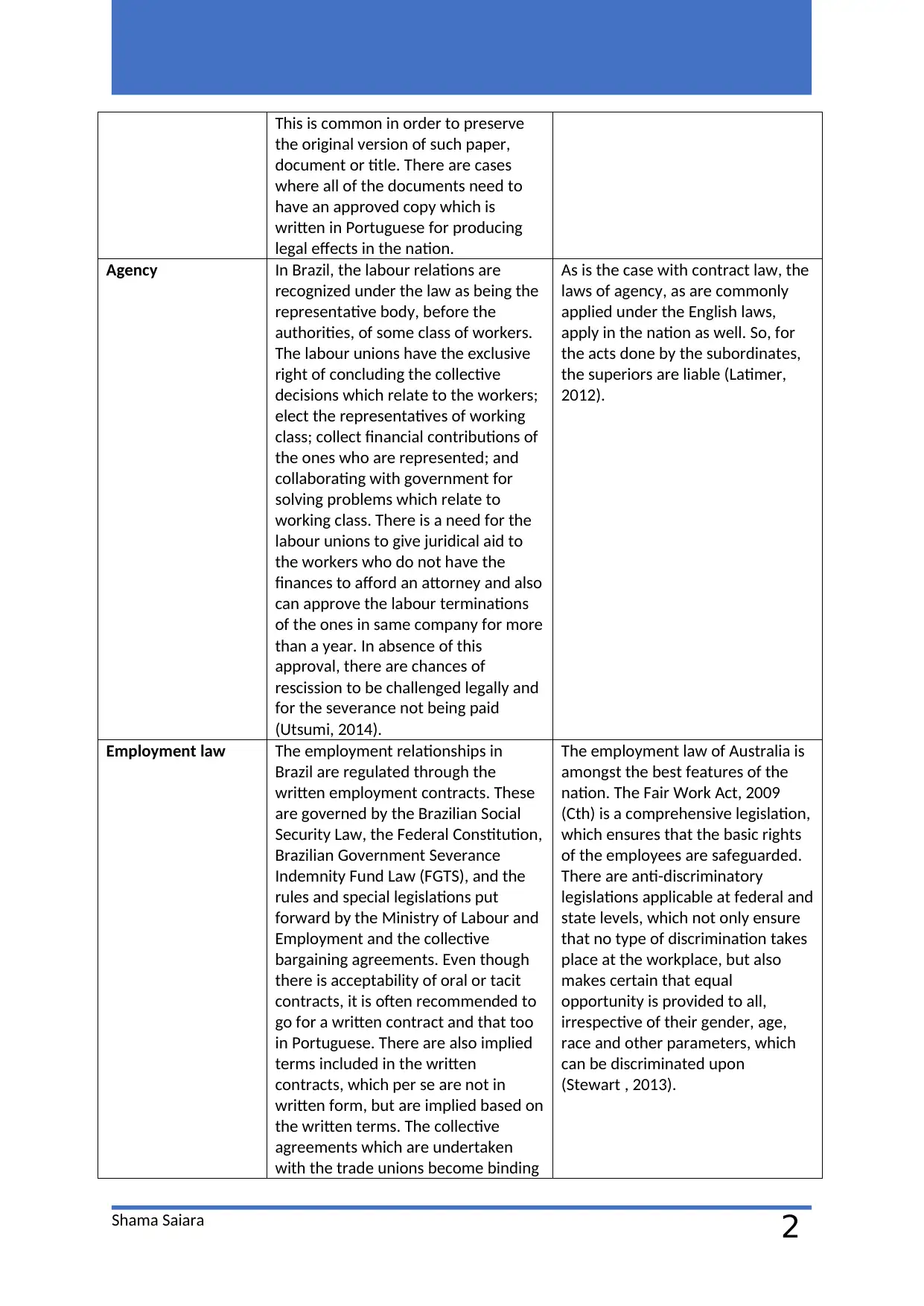
2
This is common in order to preserve
the original version of such paper,
document or title. There are cases
where all of the documents need to
have an approved copy which is
written in Portuguese for producing
legal effects in the nation.
Agency In Brazil, the labour relations are
recognized under the law as being the
representative body, before the
authorities, of some class of workers.
The labour unions have the exclusive
right of concluding the collective
decisions which relate to the workers;
elect the representatives of working
class; collect financial contributions of
the ones who are represented; and
collaborating with government for
solving problems which relate to
working class. There is a need for the
labour unions to give juridical aid to
the workers who do not have the
finances to afford an attorney and also
can approve the labour terminations
of the ones in same company for more
than a year. In absence of this
approval, there are chances of
rescission to be challenged legally and
for the severance not being paid
(Utsumi, 2014).
As is the case with contract law, the
laws of agency, as are commonly
applied under the English laws,
apply in the nation as well. So, for
the acts done by the subordinates,
the superiors are liable (Latimer,
2012).
Employment law The employment relationships in
Brazil are regulated through the
written employment contracts. These
are governed by the Brazilian Social
Security Law, the Federal Constitution,
Brazilian Government Severance
Indemnity Fund Law (FGTS), and the
rules and special legislations put
forward by the Ministry of Labour and
Employment and the collective
bargaining agreements. Even though
there is acceptability of oral or tacit
contracts, it is often recommended to
go for a written contract and that too
in Portuguese. There are also implied
terms included in the written
contracts, which per se are not in
written form, but are implied based on
the written terms. The collective
agreements which are undertaken
with the trade unions become binding
The employment law of Australia is
amongst the best features of the
nation. The Fair Work Act, 2009
(Cth) is a comprehensive legislation,
which ensures that the basic rights
of the employees are safeguarded.
There are anti-discriminatory
legislations applicable at federal and
state levels, which not only ensure
that no type of discrimination takes
place at the workplace, but also
makes certain that equal
opportunity is provided to all,
irrespective of their gender, age,
race and other parameters, which
can be discriminated upon
(Stewart , 2013).
Shama Saiara
This is common in order to preserve
the original version of such paper,
document or title. There are cases
where all of the documents need to
have an approved copy which is
written in Portuguese for producing
legal effects in the nation.
Agency In Brazil, the labour relations are
recognized under the law as being the
representative body, before the
authorities, of some class of workers.
The labour unions have the exclusive
right of concluding the collective
decisions which relate to the workers;
elect the representatives of working
class; collect financial contributions of
the ones who are represented; and
collaborating with government for
solving problems which relate to
working class. There is a need for the
labour unions to give juridical aid to
the workers who do not have the
finances to afford an attorney and also
can approve the labour terminations
of the ones in same company for more
than a year. In absence of this
approval, there are chances of
rescission to be challenged legally and
for the severance not being paid
(Utsumi, 2014).
As is the case with contract law, the
laws of agency, as are commonly
applied under the English laws,
apply in the nation as well. So, for
the acts done by the subordinates,
the superiors are liable (Latimer,
2012).
Employment law The employment relationships in
Brazil are regulated through the
written employment contracts. These
are governed by the Brazilian Social
Security Law, the Federal Constitution,
Brazilian Government Severance
Indemnity Fund Law (FGTS), and the
rules and special legislations put
forward by the Ministry of Labour and
Employment and the collective
bargaining agreements. Even though
there is acceptability of oral or tacit
contracts, it is often recommended to
go for a written contract and that too
in Portuguese. There are also implied
terms included in the written
contracts, which per se are not in
written form, but are implied based on
the written terms. The collective
agreements which are undertaken
with the trade unions become binding
The employment law of Australia is
amongst the best features of the
nation. The Fair Work Act, 2009
(Cth) is a comprehensive legislation,
which ensures that the basic rights
of the employees are safeguarded.
There are anti-discriminatory
legislations applicable at federal and
state levels, which not only ensure
that no type of discrimination takes
place at the workplace, but also
makes certain that equal
opportunity is provided to all,
irrespective of their gender, age,
race and other parameters, which
can be discriminated upon
(Stewart , 2013).
Shama Saiara
⊘ This is a preview!⊘
Do you want full access?
Subscribe today to unlock all pages.

Trusted by 1+ million students worldwide
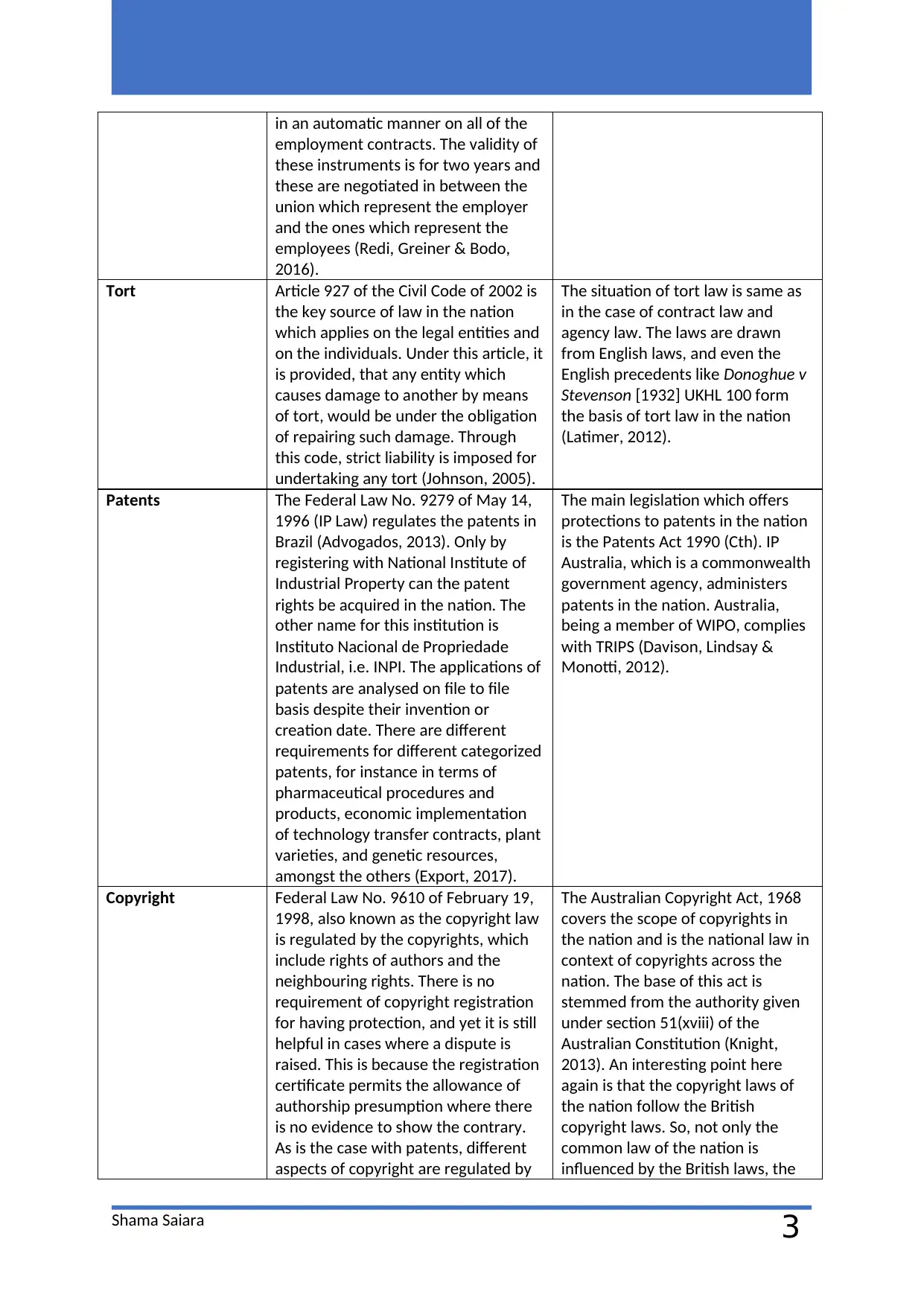
3
in an automatic manner on all of the
employment contracts. The validity of
these instruments is for two years and
these are negotiated in between the
union which represent the employer
and the ones which represent the
employees (Redi, Greiner & Bodo,
2016).
Tort Article 927 of the Civil Code of 2002 is
the key source of law in the nation
which applies on the legal entities and
on the individuals. Under this article, it
is provided, that any entity which
causes damage to another by means
of tort, would be under the obligation
of repairing such damage. Through
this code, strict liability is imposed for
undertaking any tort (Johnson, 2005).
The situation of tort law is same as
in the case of contract law and
agency law. The laws are drawn
from English laws, and even the
English precedents like Donoghue v
Stevenson [1932] UKHL 100 form
the basis of tort law in the nation
(Latimer, 2012).
Patents The Federal Law No. 9279 of May 14,
1996 (IP Law) regulates the patents in
Brazil (Advogados, 2013). Only by
registering with National Institute of
Industrial Property can the patent
rights be acquired in the nation. The
other name for this institution is
Instituto Nacional de Propriedade
Industrial, i.e. INPI. The applications of
patents are analysed on file to file
basis despite their invention or
creation date. There are different
requirements for different categorized
patents, for instance in terms of
pharmaceutical procedures and
products, economic implementation
of technology transfer contracts, plant
varieties, and genetic resources,
amongst the others (Export, 2017).
The main legislation which offers
protections to patents in the nation
is the Patents Act 1990 (Cth). IP
Australia, which is a commonwealth
government agency, administers
patents in the nation. Australia,
being a member of WIPO, complies
with TRIPS (Davison, Lindsay &
Monotti, 2012).
Copyright Federal Law No. 9610 of February 19,
1998, also known as the copyright law
is regulated by the copyrights, which
include rights of authors and the
neighbouring rights. There is no
requirement of copyright registration
for having protection, and yet it is still
helpful in cases where a dispute is
raised. This is because the registration
certificate permits the allowance of
authorship presumption where there
is no evidence to show the contrary.
As is the case with patents, different
aspects of copyright are regulated by
The Australian Copyright Act, 1968
covers the scope of copyrights in
the nation and is the national law in
context of copyrights across the
nation. The base of this act is
stemmed from the authority given
under section 51(xviii) of the
Australian Constitution (Knight,
2013). An interesting point here
again is that the copyright laws of
the nation follow the British
copyright laws. So, not only the
common law of the nation is
influenced by the British laws, the
Shama Saiara
in an automatic manner on all of the
employment contracts. The validity of
these instruments is for two years and
these are negotiated in between the
union which represent the employer
and the ones which represent the
employees (Redi, Greiner & Bodo,
2016).
Tort Article 927 of the Civil Code of 2002 is
the key source of law in the nation
which applies on the legal entities and
on the individuals. Under this article, it
is provided, that any entity which
causes damage to another by means
of tort, would be under the obligation
of repairing such damage. Through
this code, strict liability is imposed for
undertaking any tort (Johnson, 2005).
The situation of tort law is same as
in the case of contract law and
agency law. The laws are drawn
from English laws, and even the
English precedents like Donoghue v
Stevenson [1932] UKHL 100 form
the basis of tort law in the nation
(Latimer, 2012).
Patents The Federal Law No. 9279 of May 14,
1996 (IP Law) regulates the patents in
Brazil (Advogados, 2013). Only by
registering with National Institute of
Industrial Property can the patent
rights be acquired in the nation. The
other name for this institution is
Instituto Nacional de Propriedade
Industrial, i.e. INPI. The applications of
patents are analysed on file to file
basis despite their invention or
creation date. There are different
requirements for different categorized
patents, for instance in terms of
pharmaceutical procedures and
products, economic implementation
of technology transfer contracts, plant
varieties, and genetic resources,
amongst the others (Export, 2017).
The main legislation which offers
protections to patents in the nation
is the Patents Act 1990 (Cth). IP
Australia, which is a commonwealth
government agency, administers
patents in the nation. Australia,
being a member of WIPO, complies
with TRIPS (Davison, Lindsay &
Monotti, 2012).
Copyright Federal Law No. 9610 of February 19,
1998, also known as the copyright law
is regulated by the copyrights, which
include rights of authors and the
neighbouring rights. There is no
requirement of copyright registration
for having protection, and yet it is still
helpful in cases where a dispute is
raised. This is because the registration
certificate permits the allowance of
authorship presumption where there
is no evidence to show the contrary.
As is the case with patents, different
aspects of copyright are regulated by
The Australian Copyright Act, 1968
covers the scope of copyrights in
the nation and is the national law in
context of copyrights across the
nation. The base of this act is
stemmed from the authority given
under section 51(xviii) of the
Australian Constitution (Knight,
2013). An interesting point here
again is that the copyright laws of
the nation follow the British
copyright laws. So, not only the
common law of the nation is
influenced by the British laws, the
Shama Saiara
Paraphrase This Document
Need a fresh take? Get an instant paraphrase of this document with our AI Paraphraser
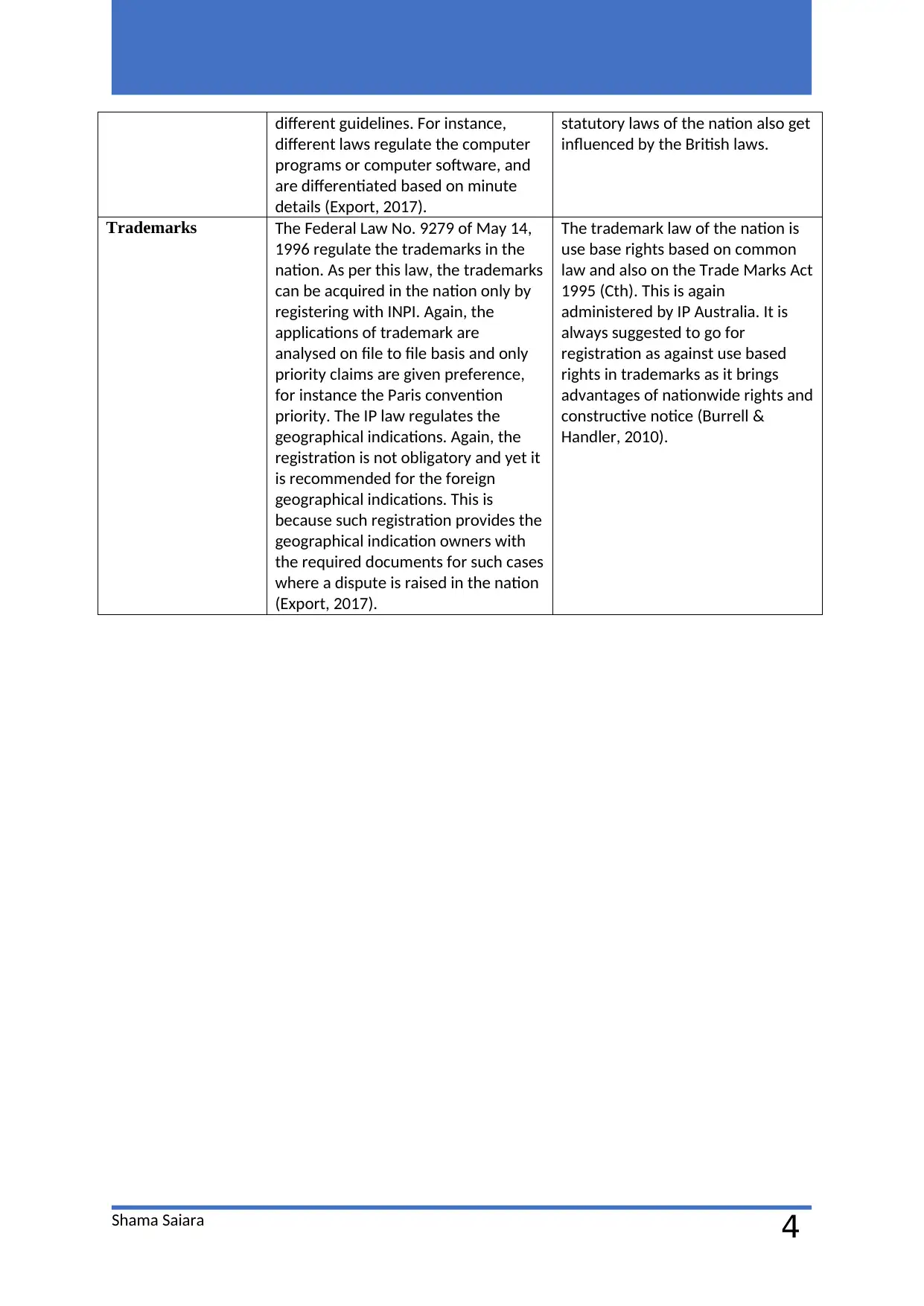
4
different guidelines. For instance,
different laws regulate the computer
programs or computer software, and
are differentiated based on minute
details (Export, 2017).
statutory laws of the nation also get
influenced by the British laws.
Trademarks The Federal Law No. 9279 of May 14,
1996 regulate the trademarks in the
nation. As per this law, the trademarks
can be acquired in the nation only by
registering with INPI. Again, the
applications of trademark are
analysed on file to file basis and only
priority claims are given preference,
for instance the Paris convention
priority. The IP law regulates the
geographical indications. Again, the
registration is not obligatory and yet it
is recommended for the foreign
geographical indications. This is
because such registration provides the
geographical indication owners with
the required documents for such cases
where a dispute is raised in the nation
(Export, 2017).
The trademark law of the nation is
use base rights based on common
law and also on the Trade Marks Act
1995 (Cth). This is again
administered by IP Australia. It is
always suggested to go for
registration as against use based
rights in trademarks as it brings
advantages of nationwide rights and
constructive notice (Burrell &
Handler, 2010).
Shama Saiara
different guidelines. For instance,
different laws regulate the computer
programs or computer software, and
are differentiated based on minute
details (Export, 2017).
statutory laws of the nation also get
influenced by the British laws.
Trademarks The Federal Law No. 9279 of May 14,
1996 regulate the trademarks in the
nation. As per this law, the trademarks
can be acquired in the nation only by
registering with INPI. Again, the
applications of trademark are
analysed on file to file basis and only
priority claims are given preference,
for instance the Paris convention
priority. The IP law regulates the
geographical indications. Again, the
registration is not obligatory and yet it
is recommended for the foreign
geographical indications. This is
because such registration provides the
geographical indication owners with
the required documents for such cases
where a dispute is raised in the nation
(Export, 2017).
The trademark law of the nation is
use base rights based on common
law and also on the Trade Marks Act
1995 (Cth). This is again
administered by IP Australia. It is
always suggested to go for
registration as against use based
rights in trademarks as it brings
advantages of nationwide rights and
constructive notice (Burrell &
Handler, 2010).
Shama Saiara
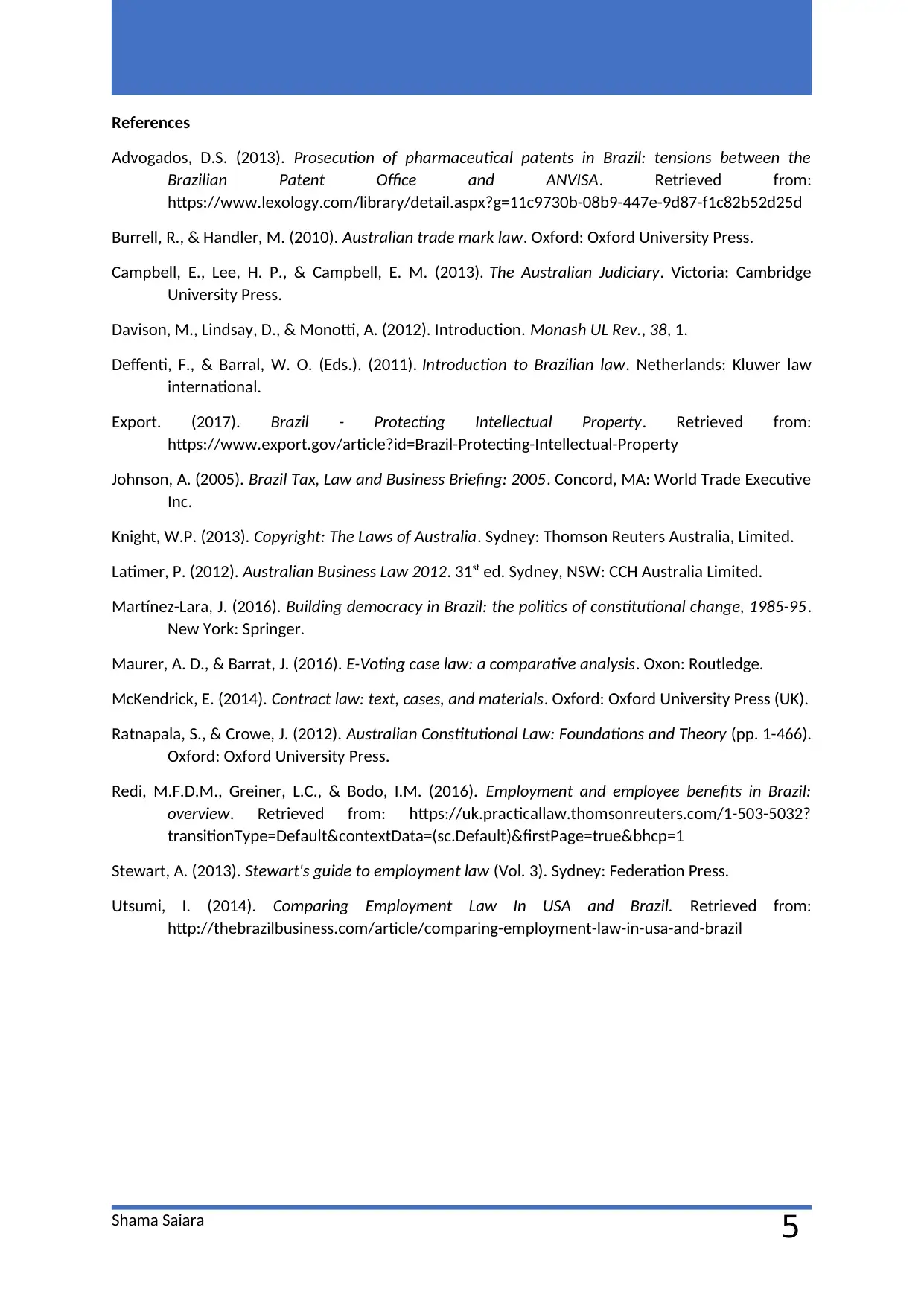
5
References
Advogados, D.S. (2013). Prosecution of pharmaceutical patents in Brazil: tensions between the
Brazilian Patent Office and ANVISA. Retrieved from:
https://www.lexology.com/library/detail.aspx?g=11c9730b-08b9-447e-9d87-f1c82b52d25d
Burrell, R., & Handler, M. (2010). Australian trade mark law. Oxford: Oxford University Press.
Campbell, E., Lee, H. P., & Campbell, E. M. (2013). The Australian Judiciary. Victoria: Cambridge
University Press.
Davison, M., Lindsay, D., & Monotti, A. (2012). Introduction. Monash UL Rev., 38, 1.
Deffenti, F., & Barral, W. O. (Eds.). (2011). Introduction to Brazilian law. Netherlands: Kluwer law
international.
Export. (2017). Brazil - Protecting Intellectual Property. Retrieved from:
https://www.export.gov/article?id=Brazil-Protecting-Intellectual-Property
Johnson, A. (2005). Brazil Tax, Law and Business Briefing: 2005. Concord, MA: World Trade Executive
Inc.
Knight, W.P. (2013). Copyright: The Laws of Australia. Sydney: Thomson Reuters Australia, Limited.
Latimer, P. (2012). Australian Business Law 2012. 31st ed. Sydney, NSW: CCH Australia Limited.
Martínez-Lara, J. (2016). Building democracy in Brazil: the politics of constitutional change, 1985-95.
New York: Springer.
Maurer, A. D., & Barrat, J. (2016). E-Voting case law: a comparative analysis. Oxon: Routledge.
McKendrick, E. (2014). Contract law: text, cases, and materials. Oxford: Oxford University Press (UK).
Ratnapala, S., & Crowe, J. (2012). Australian Constitutional Law: Foundations and Theory (pp. 1-466).
Oxford: Oxford University Press.
Redi, M.F.D.M., Greiner, L.C., & Bodo, I.M. (2016). Employment and employee benefits in Brazil:
overview. Retrieved from: https://uk.practicallaw.thomsonreuters.com/1-503-5032?
transitionType=Default&contextData=(sc.Default)&firstPage=true&bhcp=1
Stewart, A. (2013). Stewart's guide to employment law (Vol. 3). Sydney: Federation Press.
Utsumi, I. (2014). Comparing Employment Law In USA and Brazil. Retrieved from:
http://thebrazilbusiness.com/article/comparing-employment-law-in-usa-and-brazil
Shama Saiara
References
Advogados, D.S. (2013). Prosecution of pharmaceutical patents in Brazil: tensions between the
Brazilian Patent Office and ANVISA. Retrieved from:
https://www.lexology.com/library/detail.aspx?g=11c9730b-08b9-447e-9d87-f1c82b52d25d
Burrell, R., & Handler, M. (2010). Australian trade mark law. Oxford: Oxford University Press.
Campbell, E., Lee, H. P., & Campbell, E. M. (2013). The Australian Judiciary. Victoria: Cambridge
University Press.
Davison, M., Lindsay, D., & Monotti, A. (2012). Introduction. Monash UL Rev., 38, 1.
Deffenti, F., & Barral, W. O. (Eds.). (2011). Introduction to Brazilian law. Netherlands: Kluwer law
international.
Export. (2017). Brazil - Protecting Intellectual Property. Retrieved from:
https://www.export.gov/article?id=Brazil-Protecting-Intellectual-Property
Johnson, A. (2005). Brazil Tax, Law and Business Briefing: 2005. Concord, MA: World Trade Executive
Inc.
Knight, W.P. (2013). Copyright: The Laws of Australia. Sydney: Thomson Reuters Australia, Limited.
Latimer, P. (2012). Australian Business Law 2012. 31st ed. Sydney, NSW: CCH Australia Limited.
Martínez-Lara, J. (2016). Building democracy in Brazil: the politics of constitutional change, 1985-95.
New York: Springer.
Maurer, A. D., & Barrat, J. (2016). E-Voting case law: a comparative analysis. Oxon: Routledge.
McKendrick, E. (2014). Contract law: text, cases, and materials. Oxford: Oxford University Press (UK).
Ratnapala, S., & Crowe, J. (2012). Australian Constitutional Law: Foundations and Theory (pp. 1-466).
Oxford: Oxford University Press.
Redi, M.F.D.M., Greiner, L.C., & Bodo, I.M. (2016). Employment and employee benefits in Brazil:
overview. Retrieved from: https://uk.practicallaw.thomsonreuters.com/1-503-5032?
transitionType=Default&contextData=(sc.Default)&firstPage=true&bhcp=1
Stewart, A. (2013). Stewart's guide to employment law (Vol. 3). Sydney: Federation Press.
Utsumi, I. (2014). Comparing Employment Law In USA and Brazil. Retrieved from:
http://thebrazilbusiness.com/article/comparing-employment-law-in-usa-and-brazil
Shama Saiara
⊘ This is a preview!⊘
Do you want full access?
Subscribe today to unlock all pages.

Trusted by 1+ million students worldwide
1 out of 6
Related Documents
Your All-in-One AI-Powered Toolkit for Academic Success.
+13062052269
info@desklib.com
Available 24*7 on WhatsApp / Email
![[object Object]](/_next/static/media/star-bottom.7253800d.svg)
Unlock your academic potential
Copyright © 2020–2025 A2Z Services. All Rights Reserved. Developed and managed by ZUCOL.





